Bougainvillea Bougainvillea glabra 'Cypheri'

ABOUT
Bougainvillea glabra 'Cypheri', commonly known as bougainvillea, is a lush, tropical plant recognized for its vibrant and abundant flowers. This bougainvillea variety boasts rich magenta or deep purple bracts that typically surround the smaller, less noticeable true flowers. These paper-like bracts are what give bougainvillea its famous burst of color, making it a popular choice for adding a Mediterranean or tropical feel to gardens and landscapes. The leaves of the bougainvillea 'Cypheri' are typically bright green with a slightly glossy appearance and have an oval to slightly elongated shape with pointed tips. The foliage is somewhat leathery and the edges are smooth, providing a lush backdrop for the stunning bracts. Its stems are covered in sharp thorns, which can be quite formidable, and this is something to consider when planting bougainvillea near walkways or sitting areas. The plant has a sprawling growth habit that is often used to good effect in hanging baskets, climbing up trellises or spilling over garden walls to add a pop of color. Its robust and bushy appearance adds an exuberant flair to its surroundings, making it an outstanding ornamental choice.
About this plant
 Names
NamesFamily
Nyctaginaceae
Synonyms
Paper Flower, Lesser Bougainvillea
Common names
Bougainvillea spectabilis Willd., Bougainvillea speciosa Schnizl.
 Toxicity
ToxicityTo humans
Bougainvillea glabra, commonly known as bougainvillea, is not considered highly toxic to humans. However, it can cause irritation due to its tiny thorns on the stems which may lead to skin rashes or scratches if handled carelessly. Ingestion of any part of the plant is not typically associated with severe poisoning. That said, eating leaves or flowers in large quantities might result in stomach upset or discomfort, manifesting as nausea or vomiting, but these instances are relatively uncommon due to the plant's unpalatable nature.
To pets
Bougainvillea, the common name for Bougainvillea glabra, is considered to have a low level of toxicity to pets such as cats and dogs. The primary concern if pets ingest bougainvillea is gastrointestinal upset, which may present as vomiting or diarrhea. Additionally, the plant's thorns can cause physical injury by scratching or puncturing the skin or the inside of the mouth. It's always best to discourage pets from chewing on bougainvillea to prevent any discomfort or injury.
 Characteristics
CharacteristicsLife cycle
Perennials
Foliage type
Evergreen
Color of leaves
Green
Flower color
Varies
Height
15-40 feet (4.6-12 meters)
Spread
5-25 feet (1.5-7.6 meters)
Plant type
Climber
Hardiness zones
9
Native area
Brazil
Benefits
 General Benefits
General Benefits- Enhances Aesthetics: Adds vibrant color and visual interest to gardens and landscapes.
- Low Maintenance: Requires minimal care once established, making it ideal for busy gardeners.
- Drought Tolerance: Able to survive with limited water, suitable for xeriscaping and arid climates.
- Privacy Screen: Dense growth habit can provide privacy when used as a hedge or barrier.
- Erosion Control: Helps stabilize soil and prevent erosion on slopes with its thick and extensive root system.
- Attracts Wildlife: Flowers can attract pollinators like bees, butterflies, and hummingbirds.
- Adaptability: Can thrive in a variety of soil types and climatic conditions.
- Fast Growth: Rapid growth rate allows for quick establishment and coverage.
- Versatility: Suitable for growing in containers, hanging baskets, or as ground cover, depending on pruning and training.
 Medical Properties
Medical PropertiesThis plant is not used for medical purposes.
 Air-purifying Qualities
Air-purifying QualitiesThis plant is not specifically known for air purifying qualities.
 Other Uses
Other Uses- Bougainvillea glabra is often used in bonsai culture, where it can be trained into intricate and miniature tree forms to enjoy indoors or in small outdoor gardens.
- The thorny branches of the Bougainvillea can be utilized as a natural deterrent for animals or trespassers when grown along fences or property boundaries.
- The plant can be used in noise reduction barriers thanks to its dense foliage when planted in thick hedges along busy streets or highways.
- Bougainvillea flowers can be used as a natural dye, providing a range of colors from bright pinks to deep purples for fabrics and artisan crafts.
- The striking appearance of Bougainvillea blooms makes it suitable for use in floral arrangements, especially in events that demand vibrant and long-lasting decorations.
- When dried and pressed, the colorful bracts of the Bougainvillea can be used in art and craft projects, such as making bookmarks and greeting cards.
- Its vigorous climbing habit allows the Bougainvillea to be used in landscape architecture to cover unsightly walls, providing a lush and colorful facade.
- The papery texture of the Bougainvillea bracts has been utilized in the creation of eco-friendly confetti for outdoor celebrations, as they are biodegradable and non-toxic.
- Bougainvillea is used in photography and film sets as a vibrant and easily manipulated backdrop that adds a tropical or Mediterranean feel to the scenes.
- In certain cultures, the bright petals of the Bougainvillea are used to create a natural carpet for festivals and religious ceremonies, symbolizing joy and prosperity.
Interesting Facts
 Feng Shui
Feng ShuiBougainvillea is often used in Feng Shui for its vibrant energy, which can enhance the positive chi in an area. In particular, the bright flowers of the Bougainvillea can attract good luck, wealth, and success when placed in the South sector of a garden or yard. Additionally, when used near the entrance of a home or in a living space, it can create a warm, welcoming environment and may help in fostering good relationships.
 Zodiac Sign Compitability
Zodiac Sign CompitabilityThe Bougainvillea is not used in astrology practice.
 Plant Symbolism
Plant Symbolism- Passion: Bougainvillea is often associated with passion due to its vibrant and intense colors that can invoke strong feelings.
- Beauty: The plant's lush, cascading flowers symbolize natural beauty and attractiveness.
- Warmth: Native to tropical climates, bougainvillea represents warmth and welcoming, similar to the regions from which it originates.
- Vibrancy: The plant's lively colors embody a vibrant and joyful energy, often infusing spaces with a sense of celebration.
- Survival: The bougainvillea is known for its ability to thrive in harsh conditions, representing resilience and toughness.
 Water
WaterBougainvilleas, commonly referred to as Paper Flowers, prefer deep, infrequent watering to encourage a strong root system. Water the plant deeply until the excess drains out, then allow the top inch of the soil to dry out before watering again. In hot summer months, this could mean watering once a week with about 1-2 gallons depending on the size of the plant and the pot. In cooler, winter months, reduce watering to every 3-4 weeks as these plants prefer drier soil when temperatures drop. Always avoid overwatering as Bougainvilleas do not like soggy soil which can lead to root rot.
 Light
LightPaper Flowers thrive in full sun conditions, requiring at least 6 hours of direct sunlight daily. The best spot for growing Bougainvillea would be a south-facing location where it can receive ample sunlight throughout the day. It can also tolerate partial shade but flowering may be reduced. Ensure that indoor plants are positioned near a sunny window to get their required amount of sunlight.
 Temperature
TemperaturePaper Flowers grow best in temperatures ranging between 60°F and 100°F. They can survive minimum winter temperatures down to around 30°F, but frost can damage or kill the plant. The ideal temperature range for optimal growth and blooming is between 70°F and 85°F. Bougainvilleas are sensitive to cold; hence, they should be protected or brought indoors if you expect temperatures to go below the tolerance level.
 Pruning
PruningPruning Paper Flowers is important for maintaining a manageable shape and encouraging more blooms. Prune in late winter or early spring just before new growth begins, which is the best time for shaping the plant. Regularly pinch off the tips of the stems during the growing season to stimulate branching, which leads to more flowers. Prune back aggressively every few years to rejuvenate older plants and encourage fresh growth.
 Cleaning
CleaningAs needed
 Soil
SoilBougainvilleas prefer well-draining soil with a slightly acidic to neutral pH between 5.5 and 6.5. A mix of equal parts peat, coarse sand or perlite, and compost or pine bark works well. Ensure good drainage to avoid root rot.
 Repotting
RepottingBougainvillea should be repotted every two to three years or once it outgrows its current container. Trim back the roots slightly when repotting to encourage new growth.
 Humidity & Misting
Humidity & MistingBougainvilleas thrive in average to low humidity levels. They are drought-tolerant and prefer drier air, especially when temperatures are warm.
 Suitable locations
Suitable locationsIndoor
Place in bright direct light, limit water, ensure good airflow.
Outdoor
Full sun, well-drained soil, protect from frost.
Hardiness zone
9-11 USDA
 Life cycle
Life cycleBougainvillea glabra 'Cypheri', commonly known as Paperflower, starts its life as seeds which germinate in warm, well-draining soil, often requiring ample sunlight. The seedlings grow into young plants with characteristic thorny stems and vigorous vegetative growth. As the plant matures, it develops an extensive root system and woody stems, with foliage consisting of green, heart-shaped leaves. The Paperflower enters its flowering stage repeatedly throughout the year in warm climates, showcasing its showy, papery bracts that are often mistaken for flowers, with the true flowers being small and insignificant. After pollination, the plant produces small, dry fruit that contain seeds, completing its reproductive cycle. The plant can also be propagated vegetatively through cuttings, leading to quicker maturity and flowering in subsequent plants.
 Propogation
PropogationPropogation time
Spring-Summer
Bougainvillea glabra 'Cypheri', commonly known as Bougainvillea, is best propagated during its active growing season which is spring or early summer. The most popular method of propagation for Bougainvillea is through semi-hardwood cuttings. This involves taking a stem cutting of about 4 to 6 inches (10 to 15 centimeters) long from a healthy, vigorous plant. The cutting should have several sets of leaves, and the bottom set of leaves should be removed. After making the cutting, dip the cut end into rooting hormone to increase the likelihood of successful rooting. The prepared cutting should be planted in a pot filled with a well-draining potting mix and then placed in a warm area with bright, indirect light. The soil should be kept moist, but not soggy, until the cutting has rooted, which typically takes 4 to 6 weeks.
![Bougainvillea [Camarillo Fiesta]](/_next/image?url=https%3A%2F%2Fplants-admin.emdemapps.com%2Fimages%2Fplants%2F%2Fimages%2F604b5ce2e4016.png&w=640&q=75)
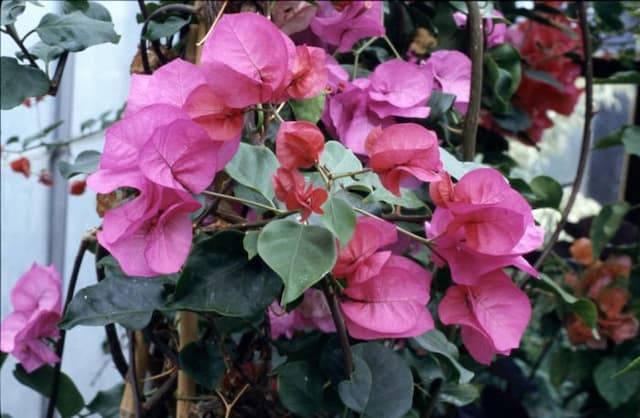



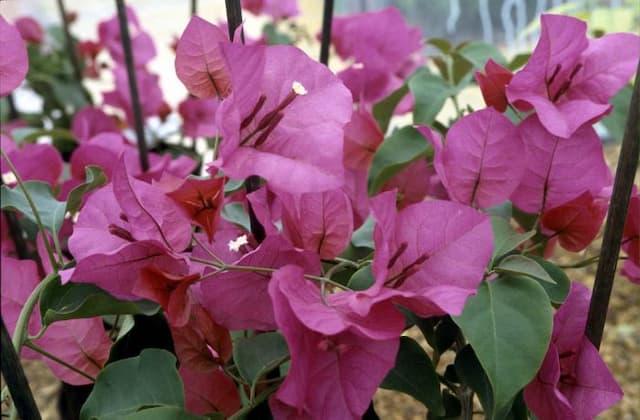
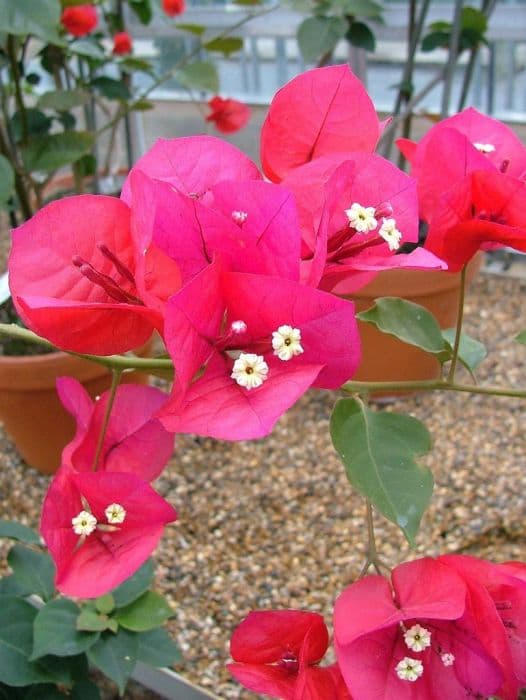
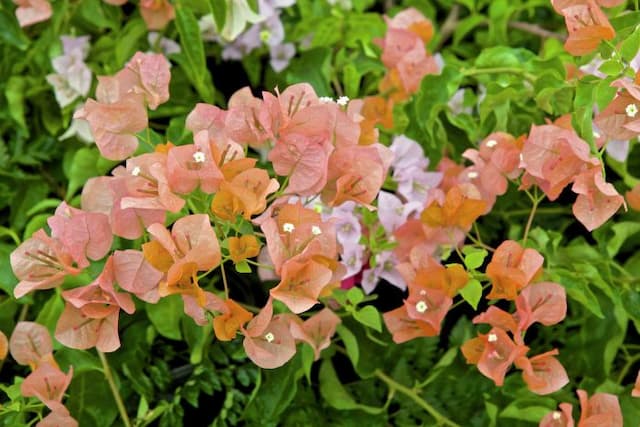
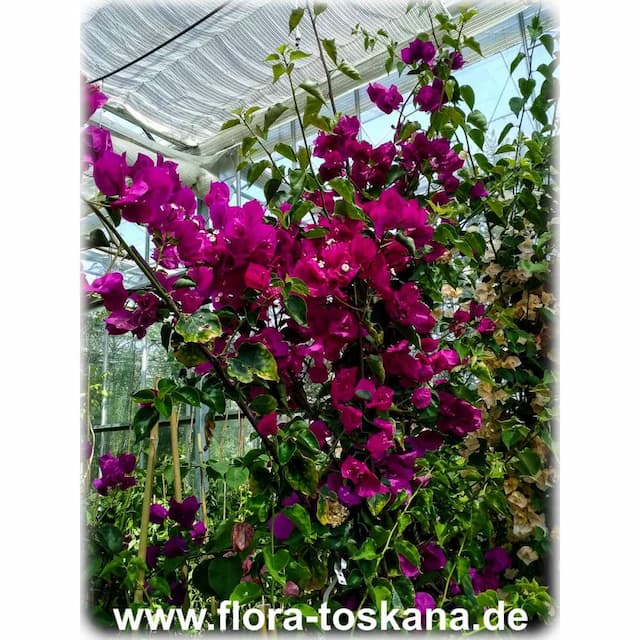
![Bougainvillea [Texas Dawn]](/_next/image?url=https%3A%2F%2Fplants-admin.emdemapps.com%2Fimages%2Fplants%2F%2Fimages%2F604b5f2598081.png&w=640&q=75)